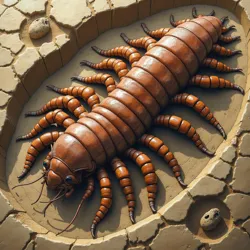Megafauna of the Madlands
The Megafauna of the Madlands represents a unique assemblage of oversized fauna endemic to the Madlands of Tla'tlaqixi, characterized by extreme adaptations, unusual behavioral patterns, and complex ecological interactions. These remarkable creatures have evolved in isolation since the 16th century, developing distinctive traits that set them apart from their counterparts in other Mesoamerican ecosystems. The region's megafauna includes both traditional large animals and arthropods of exceptional size, creating a biological community unlike any other on Earth.
 Fossilized remains of ancient megafaunal arthropods discovered during the excavation of the Temple of Living Stone
Fossilized remains of ancient megafaunal arthropods discovered during the excavation of the Temple of Living StoneHistorical Development
The emergence of the Madlands' unique megafauna coincides with the arrival of the Maqamiztleca refugees in the early 1520s. According to indigenous oral traditions, the supernatural pact made with Hmeyotlotl not only affected the refugees but also transformed the local wildlife. Historical accounts from this period describe a rapid and dramatic increase in the size and behavior of various animal species, particularly among arthropods and amphibians.
The Temple of Living Stone, discovered during the Quine Expedition, contains elaborate friezes depicting the transformation of ordinary creatures into their current megafaunal forms. These artistic representations, combined with archaeological evidence, suggest that the process occurred over several generations, with each successive generation of animals growing larger and developing more complex social behaviors.
Notable Species
Arthropod Megafauna
The Tla'tlaqixi Giant Centipede represents one of the most well-documented examples of arthropod gigantism in the region. With specimens reaching lengths of up to 68 centimeters, it exemplifies the extreme size variations found among the Madlands' invertebrates. The species demonstrates remarkable social behaviors, including cooperative hunting and communal brood care, setting it apart from its solitary relatives elsewhere.
The Crystalline Huntsman, a recently documented arachnid species, can grow to span over 40 centimeters. These translucent spiders construct elaborate communal webs incorporating strands of Hangman's Liana, creating vast architectural structures that serve both as hunting grounds and social spaces. Their complex social hierarchy and use of tools have challenged traditional understanding of arachnid intelligence.
Avian Megafauna
The Vampire Hummingbird represents an unusual case of aggressive gigantism in typically small species. These birds have evolved to be significantly larger than normal hummingbirds, with wingspans reaching up to 30 centimeters. Their distinctive feeding behavior, which involves piercing the flesh of larger animals to feed on blood rather than nectar, represents a unique adaptation to the Madlands' ecosystem.
The Shadow Macaw, with its wingspan of over two meters, demonstrates the upper size limits of avian megafauna in the region. These nocturnal birds have developed specialized feathers that absorb light, making them nearly invisible during their nighttime hunting activities. Their complex vocalizations, which can induce disorientation in prey species, suggest sophisticated hunting strategies not seen in other avian predators.
Aquatic Megafauna
The Sabre-Toothed Piranha exemplifies the extreme morphological adaptations found among the Madlands' aquatic megafauna. These fish, which can grow to lengths of over one meter, possess greatly enlarged anterior teeth and have developed the ability to survive on land for extended periods during their breeding season. Their amphibious capabilities and pack hunting behavior represent significant evolutionary innovations.
The Marsh Titan, an enormous amphibian species discovered in 2021, demonstrates the ultimate expression of megafaunal development in the region. These salamander-like creatures can reach lengths of up to four meters and possess advanced regenerative abilities that allow them to recover from severe injuries. Their complex social structure and use of bioluminescent signals for communication have made them a subject of intense scientific interest.
Ecological Interactions
The megafauna of the Madlands participate in intricate ecological relationships that challenge traditional understanding of predator-prey dynamics. Many species have developed sophisticated cooperative behaviors, forming multi-species hunting groups or defensive alliances. The relationship between the Crystalline Huntsman and the Vampire Hummingbird, for example, involves complex territorial negotiations and resource sharing that suggests a level of interspecies communication previously unknown in the natural world.
The presence of the Boneshank Fungus appears to play a crucial role in the development and maintenance of megafaunal characteristics. Research conducted by the Tla'tlaqixi Research Initiative has revealed that many megafaunal species maintain symbiotic relationships with this fungus, which may influence their growth patterns and social behaviors through chemical signaling.
Cultural Significance
The megafauna holds profound cultural importance for the indigenous inhabitants of Tla'tlaqixi. Many species play central roles in religious ceremonies and spiritual practices, particularly during the Festival of the Melting Mind. The Brotherhood of the Eternal Spore maintains detailed records of the relationships between various megafaunal species and their significance in local cosmology.
Conservation Challenges
The preservation of the Madlands' megafauna presents unique challenges for conservation efforts. The Tla'tlaqixi Conservation Trust has implemented specialized protocols for studying and protecting these species, particularly given their aggressive tendencies and the complex web of ecological relationships they maintain. The phenomenon known as Tla'tlaqixi Fever has complicated research efforts, as extended exposure to certain megafaunal species appears to induce altered states of consciousness in human observers.
See also
- Biological Anomalies of the Yucatan
- Endemic Species of Tla'tlaqixi
- Evolutionary Acceleration in Isolated Ecosystems
References
The study of the Madlands' megafauna relies heavily on field observations conducted through the Tla'tlaqixi Research Initiative, supplemented by indigenous knowledge and historical records. Many aspects of these creatures' biology and behavior remain poorly understood due to the challenges of conducting research in their habitat and the unique phenomena associated with their study.